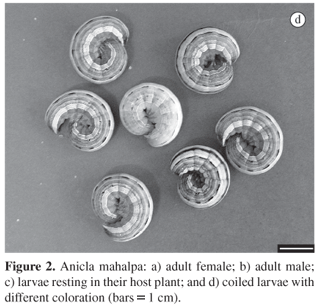The genus Anicla Grote, 1874 is composed of eleven species; their larvae are harmful, mainly to native and cultivated grasses, but up to now, there is information available of only two species. This study aims at detailing the bionomy of A. mahalpa Schaus; the data were obtained from a laboratory rearing under the following settings: 20 ± 2 ºC, 70 ± 10% relative humidity and 12 hours of photoperiod. Larvae were fed on ryegrass, Lolium multiflorum Lam. (Poaceae). The results expressed by the mean and respective standard error for the periods of each phase, in days, were the following: egg 6.00 ± 0.00, larva 36.47 ± 0.44, pre-pupa 5.23 ± 0.21, pupa 23.60 ± 0.37, and adult: longevity 15.24 ± 0.75 with pre-egg-laying-periods of 5.29 ± 0.32; egg-laying period, 9.64 ± 0.81, and post-egg-laying period, 0.71 ± 0.27 days. The mean number of egg-laying cycles per female was 7.36 ± 0.20 and 2,014.21 ± 78.93 eggs per female. Eggs, which are subspheric, have a diameter of 0.76 ± 0.01 mm; larvae passed through six instars; their head capsules width, provided a mean ratio of growth of 1.482. Pupae presented a mean width and length of 6.07 ± 0.06 and 17.24 ± 0.19 mm, respectively and weight of 0.33 ± 0.01 g.
agricultural importance; caterpillar; development; insecta






